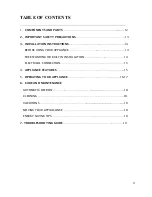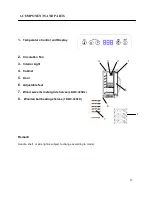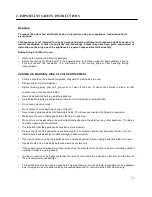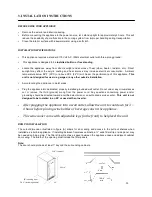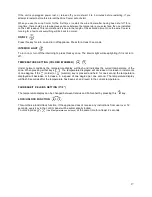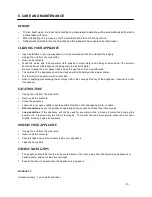
7.TROUBLESHOOTING GUIDE
You can solve many common appliance problems easily, saving you the cost of a possible service
call. Try the suggestions below to see if you can solve the problem before calling for service.
PROBLEMS
POSSIBLE CAUSES
Display flash and indicate “HH”, flash speed
one time per second
The temperature sensor of zone is less then
37
°
C
Display flash and indicate “LL”, flash speed
one time per second
The temperature sensor of zone is less then
0
°
C
Display flash and indicate “E0”, flash speed
one time per second
Connection failure, wire or component is not
connected tightly
Display flash and indicate “E1”, flash speed
one time per second
The temperature sensor is malfunctioning in
corresponding zone
Display flash and indicate “E2”, flash speed
one time per second
The defrost sensor (coil senor) is
malfunctioning in corresponding zone
Appliance does not operate.
The unit is not plugged in.
The circuit breaker has tripped or there is a blown
fuse.
Temperature inside the appliance is too warm.
Temperature control is set too warm. Turn the
control to a cooler setting and allow several hours
for the temperature to stabilize.
Door is kept open too long or is opened too
frequently. Warm air enters the appliance every
time the door is opened. Open the door less
often.
The door is not closed completely.
The door gasket does not seal properly.
The appliance has recently been disconnected
for a period of time. Note:4 hours are required for
the appliance to cool down completely.
Temperature inside the appliance is too cold.
Temperature control is set too cold. Turn the
control to a warmer setting and allow several
hours for the temperature to stabilize.
Vibrations.
Check to assure that the appliance is on a level
surface.
The appliance is touching the wall. Re-level the
appliance and move it from the wall.
If continued vibration occurs, turn off the
appliance and unplug the power plug. Contact
Customer Service Dept. for further assistance.
Moisture forms on inside appliance walls.
The door is slightly open.
The door is kept open too long, or is opened too
frequently. Open the door less often.
The door is not sealed properly.
Moisture forms on outside of appliance.
The door is slightly open, causing cold air from
inside the appliance to meet warm moist air from
outside.
The door will not close properly.
The appliance is not on a level surface.
The gasket is dirty or damaged.
TO CONTACT THE AUTHORIZED SERVICE CENTER:
A.G.I SERVICE
450.963.1303/1.888.651.2534
19


